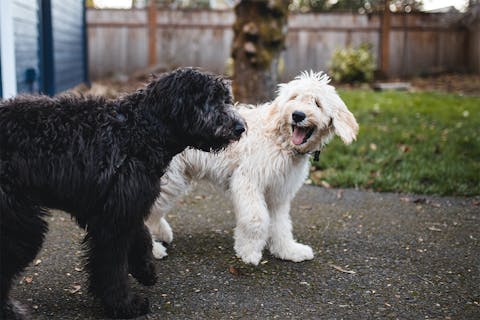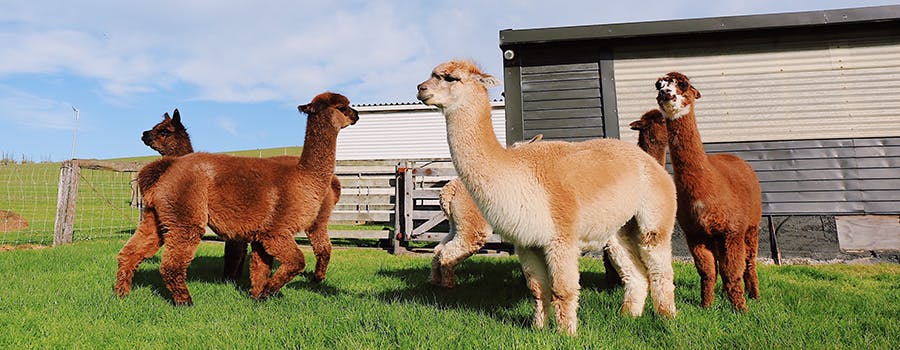Updated 19th May 2025
Worried your dog might be suffering from separation anxiety? While it’s sadly a common issue that pet parents deal with, there are ways to counter-condition your dog. So to help your anxious furry friend, stick with us and explore this vet-approved guide to separation anxiety in dogs.
Scroll to learn about what dog separation anxiety is, the signs, treatments, how to calm an anxious dog, how to help a dog with separation anxiety, and how to prevent it.
What is separation anxiety in dogs?
Separation anxiety in dogs is a behavioral issue that causes feelings of distress and fear. It’s caused by separation from owners or familiar caregivers, and can result in unwanted behaviors, including howling, barking, chewing, digging and soiling in unwanted places.
What are the signs of separation anxiety in dogs?
If you think your dog might be suffering when you’re out of the house, take a look below at the symptoms of anxiety in dogs.
Changes in where they pee and poop
One of the most common dog anxiety symptoms is that your dog starts peeing and pooping indoors whenever you’re out of the house. If they’re soiling inside the home when you’re present, it’s likely that the behavior isn’t caused by canine separation anxiety. In any case, speak to your vet for advice.
Vocalization
Dogs with separation anxiety are also prone to whining, barking and howling when you leave, and if you’re gone for a long time.
Destructive behaviors
Another common sign of separation anxiety in dogs is chewing and destroying objects. Your dog might also dig excessively. These behaviors might be due to frustration and anxiety, along with an attempt to escape.
A change in eating habits
If your dog has separation anxiety, they might stop eating, drink water excessively, or may demonstrate coprophagia (eating their own poop).
A change in behavior towards family members
You might find that your dog follows you around the home and becomes anxious when you leave the room. If your dog shows signs of distress when you prepare to leave the house or they’re elated when you get home, they likely have canine separation anxiety.
Other physical signs of separation anxiety in dogs:
- Panting
- Pacing
- Salivating and drooling
- Increased heart rate
- Increased respiration rate
Trending posts
Purr-use some of the top blogs our members have been loving this month- Top male dog names for your new furry friendGot a new furry family member in your pack? Check…

- Top female dog names for your new fluffy palWelcoming a new pooch into your family? Explore…

- 250+ gray cat names your silver feline will loveRecently welcomed a fluffy gray bundle of joy into…

- What are normal pet sitting rates?Discover the average pet sitting rates for animals…

- Unique dog names to stand out from the packDare to be different with our list of the best…

Other medical problems that can cause similar symptoms to separation anxiety in dogs
The signs of canine separation anxiety can be a sign of other issues, so it’s important to rule it out. Explore the common causes of similar symptoms, and speak to your vet for advice.
Incontinence
If your dog is peeing and pooping indoors all of a sudden - and they’re toilet-trained - it could be a sign of incontinence, rather than separation anxiety. Speak to your vet if you’ve noticed a change in your dog’s bathroom habits.
Medication
If your dog is showing signs of separation anxiety and they’ve recently started taking a new medication, it could be down to that, rather than canine anxiety. Speak to your vet if you think your dog might be experiencing side effects to medication.
Why do dogs get separation anxiety?
The key to curing dog separation anxiety quickly is to start by understanding the route cause. Below, find the reasons a dog might develop separation anxiety.
A change in owner
One of the most common reasons for canine separation anxiety is a change in owner. Perhaps the dog has been abandoned in the past, or the previous owner had to put them in a shelter. Whatever your dog’s history, a change in owner is a huge adjustment, and they may have a fear of being left alone as a result.
A change in household members
If a member of the household moves away (like a son or daughter going away to university), or one member gets a full time job out of the house, your dog might experience separation anxiety.
Moving home
Moving house is a testing time for dogs - they’re creatures of habit and get great comfort from their familiar surroundings. So if you’ve recently moved home, your dog might experience some of the symptoms of separation anxiety when you’re gone.
A change in routine
A sense of routine makes dogs feel safe and secure, and any changes in it can result in separation anxiety. For example, if you’ve always worked from home and are now suddenly out of the house more often, your dog might experience separation anxiety. This can especially ring true for puppies and separation anxiety, where owners initially dedicate lots of their time to their new dog, only to go back to their normal routine which requires the dog to be alone at home.
How to treat separation anxiety in dogs
Want to know how to cure separation anxiety in dogs? The best advice is to speak to your vet, but below find some of the common ways dog owners can combat canine separation anxiety at home:
Counter-conditioning for mild separation anxiety in dogs
In cases of mild separation anxiety, you can try simple counter-conditioning. This involves training your dog to look forward to you leaving the house, rather than reacting negatively.
Give your dog a treat and a fun toy, or even a toy stuffed with something yummy when you leave the house.
Not only will this distract your dog from the fact that you’ve gone out, but it will also help them to associate you leaving with positive experiences. In time, your dog might actually look forward to you going out.
Avoid fuss
Helping to cure your dog’s separation anxiety can begin with your own behavior modification. Create little fuss when you leave the house and when you return home. This will help your dog to remain calm when you go out, and to see you coming and going as no big deal.
Desensitize them to your departure
Dog separation anxiety training can also look like getting your pooch used to you preparing to leave the house. This is because your dog’s separation anxiety can start from you putting your shoes on, or picking up your keys.
So to get your dog accustomed to the ritual, pick up your keys or put on your coat and then stay in the house. This will break the association between these signals and your dog’s anxiety, and desensitize them to things you can’t avoid doing.
Create a comfortable home environment
Creating a comforting, confined safe space for your dog. This could look like a room filled with toys and with a window to look out of. Be sure to exclude anything they could destrong, and include an item of your clothing to make sure your dog feels comforted while you’re out.
Tire them out with exercise and mental stimulation
Provide your dog with exercise and mental stimulation before you leave the house - take them on a new walking route they haven’t seen before or play a few training games.
Invest in a dog anxiety vest
Invest in a dog anxiety vest for canine stress relief. They provide a gentle, constant pressure that feels like a hug and promotes a sense of wellbeing, and in many cases, reduces anxiety in dogs.
Treatments for severe canine separation anxiety
If your pooch is severely stressed, you might want to contact a canine behavior therapist or a veterinary behaviorist to work out a plan for gradually reducing your pet’s fear and implementing dog anxiety treatment.
One way severe separation anxiety can be addressed is by leaving your dog for short periods of time, then gradually increasing the time you’re away. The length of time you leave your dog for should be short at the start, and it’s best to initially just stand outside, or go to the next room.
Welcome a dog sitter
Did you know that vets agree pets are happier at home? Well even though your pooch might be anxious when you leave, uprooting them and placing them in a shelter could be even worse. So instead, welcome a verified, in-home pet sitter to give them the TLC they need, while you enjoy a trip away.
Most dogs with separation anxiety are simply worried about being alone, so they are comforted by having another human in the home, and the sitter can be instructed to maintain your dog’s usual routine.
To find out how to connect with a verified pet sitter to suit your dog’s needs, click below.
Connecting with pet sitters
How to prevent separation anxiety in dogs
To prevent your dog from developing separation anxiety in the long term, there are a few things pet parents can do:
Desensitize them as a puppy
The key way to prevent separation anxiety in dogs is by training them to feel comfortable being left alone while they’re still a puppy. Naturally puppies need more attention at times, but get them used to being left alone in a room, and then out of the house for short periods of time to avoid puppy separation anxiety. Gradually build up to the maximum amount of time your dog will be left alone for in adulthood.
Crate training
One way to make your dog feel safe at home is with crate training. Stuff it with their favorite toys, chews, blankets and cushions so that it becomes a safe and welcoming place for your dog.
Begin training your puppy to feel comfortable being left alone in their crate by leaving the room for a short while, then providing a treat just before you step out.
Remember that not all dogs will get used to being in a crate and sometimes will show signs of stress. Avoid using a crate with these dogs.
Gradually lengthen the time you’re out
Gradually lengthen the time you spend out of the room, and eventually your dog should feel comfortable being by themselves - whether that’s in a crate or not.
Bear in mind that separation anxiety isn’t preventable in the case of every dog. Just like humans, every dog is different. And even a well-trained dog might begin to show signs of separation anxiety later in life, possibly triggered by a traumatic event.
What to avoid with a dog who’s got separation anxiety
Just like humans with anxiety, dogs with separation anxiety do not react well to being scolded or shouted at. Punishing a distressed dog for their behavior is only likely to make things worse.
Likewise, obedience training is unlikely to help, since the unhappy dog isn’t being disobedient, they’re just anxious.
Always consult a canine or veterinary behaviorist in cases of moderate to severe separation anxiety.
Signs of separation anxiety in cats and what to do about them
The signs of separation anxiety in cats are broadly similar to the signs in dogs listed above, although there are a few different behaviors to look for. These include excessive self-grooming and vomiting food or hairballs.
Likewise, some of these behaviors could be linked to a medical problem, so check with a vet if you’re not sure to rule out medical problems.
The ways to treat separation anxiety in cats are similar to separation anxiety treatments for dogs. Namely, you should try to:
- Minimize fuss when leaving the house.
- Get them used to cues indicating you’re leaving, such as putting on your coat without leaving the house.
- Create a safe, fun space for your cat to stay in with a perch where they can look out of the window.
- Provide lots of toys for them to play with.
- Give them a treat or interesting toy when you leave the house, such as a toy with hard-to-extract food inside or a puzzle feeder.
- You may want to consider the use of plug-in synthetic pheromones that can help with stress.
As with dogs, more serious cases might require advice from a feline therapist and a structured course where you leave the house for a very short time, then gradually build up to longer intervals.
Useful resources
- What are dog calming pheromones and how do they work?
- Crate training a puppy: A step-by-step guide to success
- How to crate train an older dog
- Anxiety wraps for dogs: A gentle hug
- 6 dog anxiety vests to calm a nervous pooch
- 5 of the best dog toys for separation anxiety
- What can I give my dog for anxiety?
- Everything you need to know about cat separation anxiety
Meet our veterinary expert, Aisling
This article has been checked by veterinarian Aisling O’Keeffe MVB CertSAM ISFMCertAdvFB. Aisling qualified as a vet 7 years ago from University College Dublin. She has worked in a mixture of UK small animal hospitals along with Irish practices. She worked for 3 years in a feline-only hospital where she further developed her feline medicine and surgery skills. She currently lives and works in a small animal hospital in Cork, Ireland.
Separation anxiety in dogs: FAQs
How long can a dog be left alone?
It depends on your dog’s age, breed and history (such as traumatic events), but it’s generally recommended not to leave your dog alone for longer than four hours.
Why does my dog howl when I leave?
Your dog may be howling when you leave due to canine separation anxiety. Speak to your vet and take action to reduce your pup’s separation anxiety, such as counter-conditioning.
Can separation anxiety cause diarrhea in dogs?
Yes, stress caused by separation anxiety in dogs can result in diarrhea. Speak to your vet if your dog is having diarrhea, as it could be down to other gastrointestinal issues, toxicity or a reaction to medication.
How long does separation anxiety last in dogs?
Separation anxiety in dogs can continue until the problems and causes are addressed. It can take months or even years to properly overcome the fear of being left alone.
Can separation anxiety cause vomiting in dogs?
Yes, vomiting is a symptom of canine separation anxiety. If your dog is experiencing this, it’s vital you address these issues and speak to your vet for advice.

